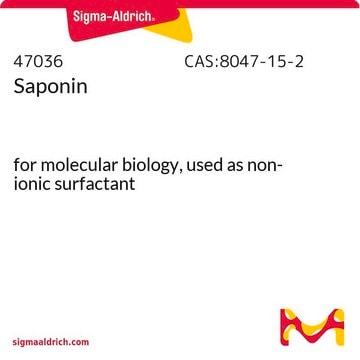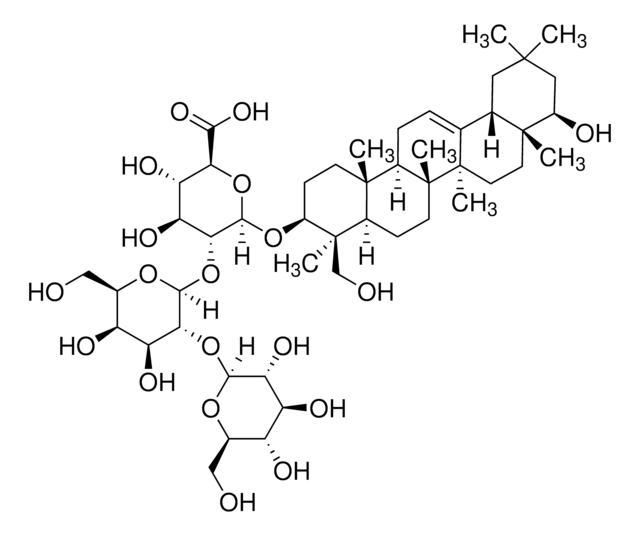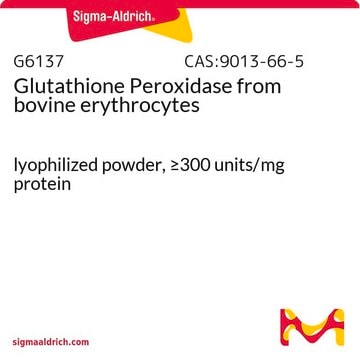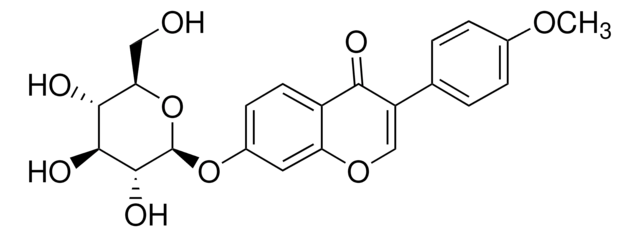S9951
Soyasaponin I
Synonym(s):
SCM 3B, Soyasaponin Bb
About This Item
Recommended Products
biological source
Glycine max (soybean)
Assay
≥94% (HPLC)
form
powder
storage condition
protect from light
solubility
ethanol: 1 mg/mL, clear, colorless
application(s)
metabolomics
vitamins, nutraceuticals, and natural products
storage temp.
2-8°C
SMILES string
CC1(C)C[C@@H](O)[C@@](CC[C@]2(C)C3=CC[C@@]4([H])[C@@]2(C)CC[C@]5([H])[C@]4(C)CC[C@H](O[C@]6([H])O[C@H](C(O)=O)[C@@H](O)[C@H](O)[C@H]6O[C@@]7([H])[C@H](O[C@]8([H])O[C@@H](C)[C@H](O)[C@@H](O)[C@H]8O)[C@@H](O)[C@@H](O)[C@@H](CO)O7)[C@@]5(CO)C)(C)[C@@]3([H])C
InChI
1S/C48H78O18/c1-21-29(52)31(54)35(58)40(61-21)65-37-32(55)30(53)24(19-49)62-41(37)66-38-34(57)33(56)36(39(59)60)64-42(38)63-28-12-13-45(5)25(46(28,6)20-50)11-14-48(8)26(45)10-9-22-23-17-43(2,3)18-27(51)44(23,4)15-16-47(22,48)7/h9,21,23-38,40-42,49-58H,10-20H2,1-8H3,(H,59,60)/t21-,23-,24+,25+,26+,27+,28-,29-,30-,31+,32-,33-,34-,35+,36-,37+,38+,40-,41-,42+,44+,45-,46+,47+,48+/m0/s1
InChI key
PTDAHAWQAGSZDD-IOVCITQVSA-N
Looking for similar products? Visit Product Comparison Guide
Related Categories
General description
Application
- to test its effect on migration and invasion of ovarian cancer cell lines
- as standard for the quantification of saponins from quinoa and fenugreek samples
- as L-15 medium supplement for Zebrafish liver cell lines
Biochem/physiol Actions
Storage Class Code
11 - Combustible Solids
WGK
WGK 3
Flash Point(F)
Not applicable
Flash Point(C)
Not applicable
Certificates of Analysis (COA)
Search for Certificates of Analysis (COA) by entering the products Lot/Batch Number. Lot and Batch Numbers can be found on a product’s label following the words ‘Lot’ or ‘Batch’.
Already Own This Product?
Find documentation for the products that you have recently purchased in the Document Library.
Customers Also Viewed
Our team of scientists has experience in all areas of research including Life Science, Material Science, Chemical Synthesis, Chromatography, Analytical and many others.
Contact Technical Service












